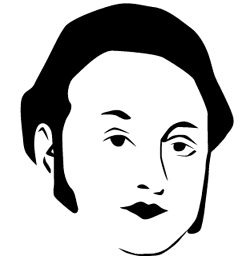
 Lorenzo
De Zavala
Lorenzo
De Zavala
|

 Lorenzo
De Zavala
Lorenzo
De Zavala
Lorenzo
De Zavala, (1788-1836). Manuel Lorenzo Justiniano de Zavala y Sáenz, first vice
president of the Republic of Texas, the fifth of nine children of Anastasio de
Zavala y Velázquez and María Bárbara Sáenz y Castro, was born in the village
of Tecoh near Mérida, Yucatán, on October 3, 1788. After graduating from the
Tridentine Seminary of San Ildefonso in Mérida in 1807, he founded and edited
several newspapers in which he expressed those democratic ideas that were to be
the hallmark of his political career, ideas which he continued to advocate while
serving as secretary of the city council of Mérida from 1812 until 1814. His
support of democratic reforms led to his imprisonment in 1814 in the fortress of
San Juan de Ulloa in the harbor of Veracruz, where he gained enough knowledge
from reading medical textbooks to qualify him to practice medicine upon his
release from prison in 1817. He also taught himself to read English during his
imprisonment. After serving as secretary of the provincial assembly of Yucatán
in 1820, Zavala went to Madrid in 1821 as a deputy to the Spanish Cortes. Upon
his return to Mexico, he joined the leaders of the new nation in establishing a
republican government. From 1822 until his death, he was one of the nation's
most active political leaders, representing Yucatán as a deputy in the First
and Second Mexican Constituent congresses of 1822 and 1824 and in the Mexican
Senate from 1824 to 1826. In the following two years, marked by the internecine
struggle between the Federalists and Centralists for control over both national
and state governments, Zavala served intermittently as governor of the state of
Mexico. When Vicente Ramón Guerreroqv became president, Zavala was appointed
secretary of the treasury and served from April to October 1829. When the
Centralist party, led by Vice President Anastacio Bustamante,qv ousted Guerrero
late in the year, Zavala, a strong Federalist, was forced to abandon politics
and, after a period of house arrest, to go into exile in June 1830.
Upon his arrival in New York, Zavala sought to interest eastern capitalists in
the empresarioqv grants he had received on March 12, 1829, which authorized him
to settle 500 families in a huge tract of land in what is now southeastern
Texas. In New York City, in October 1830, he transferred his interest in the
grants to the Galveston Bay and Texas Land Company.qv After spending several
months during 1831 in France and England, Zavala resided in New York City until
his return to Mexico in the summer of 1832. From December 1832 until October
1833 he again served as governor of the state of Mexico, before returning to the
Congress as a deputy for his native state of Yucatán. Named by President
Antonio López de Santa Annaqv in October 1833 to serve as the first minister
plenipotentiary of the Mexican legation in Paris, he reported to that post in
the spring of 1834. When he learned that Santa Anna had assumed dictatorial
powers in April of that year, Zavala denounced his former ally and resigned from
his diplomatic assignment. Disregarding Santa Anna's orders to return to Mexico
City, he traveled to New York and then to Texas, where he arrived in July 1835.
From the day of his arrival, he was drawn into the political caldron of Texas
politics. Although he first advocated the cause of Mexican Federalism, within a
few weeks he became an active supporter of the independence movement; he served
in the Permanent Councilqv and later as the representative of Harrisburg in the
Consultation and the Convention of 1836.qv
Zavala's legislative, executive, ministerial, and diplomatic experience,
together with his education and linguistic ability, uniquely qualified him for
the role he was to play in the drafting of the constitution of the Republic of
Texas.qv His advice and counsel earned him the respect of his fellow delegates,
who elected him ad interim vice president of the new republic. In the weeks
after adjournment of the convention, Zavala rejoined his family at their home at
Zavala Point on Buffalo Bayou, from where they fled to Galveston Island as Santa
Anna's army pursued Zavala and other cabinet members across Texas. In accordance
with the provisions of the Treaties of Velasco,qv Zavala was appointed, on May
27, 1836, one of the peace commissioners to accompany Santa Anna to Mexico City,
where the general was to attempt to persuade the Mexican authorities to
recognize the independence of Texas. The frustration of this plan by certain
Texas military units brought an end to the peace commission. Shortly thereafter,
Zavala returned to his home in poor health and relinquished his part in the
affairs of state. He resigned the vice presidency on October 17, 1836. Less than
a month later, soaked and half-frozen by a norther after his rowboat overturned
in Buffalo Bayou, he developed pneumonia, to which he succumbed onNovember 15,
1836. He was buried at his home in a small cemetery plot marked by the state of
Texas in 1931. The plot has since sunk into Buffalo Bayou. In the twenty-five
years after 1807 when Zavala became politically active, he demonstrated his
skills as a writer in uncounted articles and editorials in newspapers in Mérida
and Mexico City, and in a large number of pamphlets and memorials. He is best
known as an author for his two-volume history of Mexico, which first appeared
under the title Ensayo histórico de las revoluciones de México desde 1808
hasta 1830 (Paris and New York, 1831 and 1832), and for his Viage á los
Estados-Unidos del Norte de América (Paris, 1834), in which he described
economic, political, and social phenomena he observed during his visit to the
United States in 1830-31.
Zavala's first wife was Teresa Correa y Correa, whom he married in Yucatán in
1807. They had three children, including Lorenzo, Jr., who served his father in
Paris as secretary of legation and, after the battle of San Jacinto,qv served as
translator for Sam Houstonqv in his negotiations with Santa Anna. Zavala's wife
died in the spring of 1831, and he married Emily West (see ZAVALA, EMILY WEST
DE), a native of Rensselaer, New York, in New York City on November 12, 1831. To
this union were born three children; Augustine, the eldest, was the father of
Adina Emilia de Zavala,qv who long will be remembered for her spirited role in
the fight to preserve the Alamo. Zavala's memory is preserved in Texas in a
number of place names, notably Zavala County, a village in Jasper County, and a
rural settlement in Angelina County, and in numerous street and school names.
BIBLIOGRAPHY: "ZAVALA, LORENZO DE." The Handbook of Texas Online. <http://www.tshaonline.org/handbook/online/articles/view/ZZ/fza5.html>
[Accessed Tue Jun 13 15:03:12 2000 ]. Raymond Estep, The Life of Lorenzo de
Zavala (Ph.D. dissertation, University of Texas, 1942). Raymond Estep,
"Lorenzo de Zavala and the Texas Revolution," Southwestern Historical
Quarterly 57 (January 1954). Margaret Swett Henson, Lorenzo de Zavala (Fort
Worth: Texas Christian University Press, 1996).
Raymond Estep